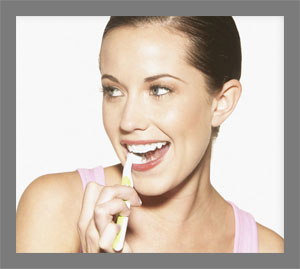Home Care
Adults over 35 lose more teeth to gum disease (periodontal disease) than from cavities. Three out of four adults are affected at some time in their life. The best way to prevent cavities and periodontal disease is by good, daily tooth brushing and tooth flossing techniques.
Periodontal disease and decay are both caused by bacterial plaque. Plaque is a colorless film that sticks to your teeth at the gum line. Plaque constantly forms on your teeth. By thorough daily brushing and flossing, you can remove these germs and help prevent periodontal disease.
1) The 1 2 3 of brushing

i-The first step is to choose a good toothbrush. You should always want to use a soft brush with a small head. A soft brush is hard enough to remove plaque, yet gentle enough not to damage your teeth or gums.
ii-The second step is to select good toothpaste. In general, any toothpaste that contains Fluoride will do the job, unless you have special needs that are determined by your dentist. Two of the best brands of toothpastes are Colgate Total ,Pepsodent
iii-The thumb of rule for brushing is to start from a specific location and work your way to the opposite side, continuing all the way through the whole mouth so that you end where you started. This way you won't miss any area. Usually a pea-sized amount of toothpaste is enough. An adequate brushing should at least take 2 minutes and preferably around 4 minutes.
iv-There are a variety of techniques for brushing your teeth, but one of the most popular ones is described here:
Hold the brush at a 45 degree angle toward the teeth and gums. Gently press against the gums so the tips of the bristles go in between the gum and the teeth. Then apply a few lateral strokes and roll down the brush to sweep the plaque away from the teeth and the gum. Repeat this motion 6 to 10 times and move on to the next area of 2 to 3 teeth. If your mouth is full of foam, spit out and continue brushing. Your brushing is completed when you have brushed all the surfaces of your teeth, not when your mouth is full! On chewing surfaces, short strokes work best to get the plaque out of the grooves and pits. When brushing the back side of your front teeth, hold your brush vertically to be able to reach the teeth better.
As far as frequency of brushing is concerned, ideally you want to brush your teeth after each meal. But if you can’t, brush at least twice a day- in the morning and before going to bed.
2) Teeth Flossing

The surfaces that are between teeth are not accessible to brush; therefore, the best way to clean them is by flossing. The frequency of flossing is like brushing and ideally after each meal, though one time a day (before going to bed) is the minimum necessary.To start, cut a piece of dental floss (approximately 2 feet). Wrap both sides of the floss around your middle fingers. Using your index and thumb, glide the floss in between all your teeth one by one. When flossing, make sure you are not cutting your gums. The goal is to clean the teeth surfaces, not the gums. In the space in between teeth, press the floss against each side of the tooth (hug the tooth) and gently move it back and forth and up and down. Then move to the opposite surface of the adjacent tooth.
3) Manual Vs Electronic Brushes

There have been multiple studies comparing the effectiveness of manual brushes as opposed to electric brushes. These studies conclude that in general manual brushes are as efficient in controlling plaque as electronic brushes. You can do a very good brushing with a regular hand brush, but the movements of an electric brush make the task easier when you are talking about someone with orthodontic braces or history of gum disease .





